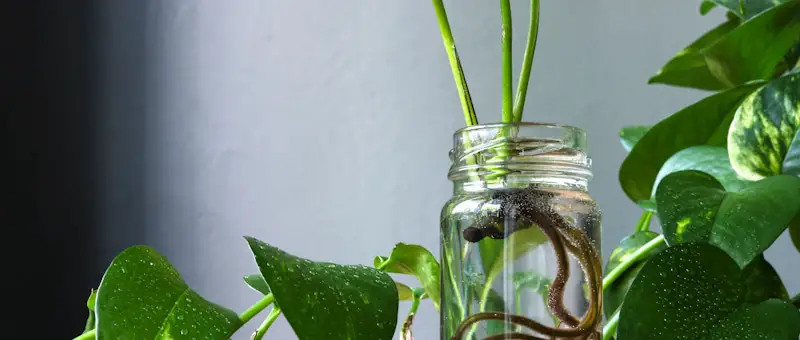If you are a houseplant enthusiast, you have probably seen or grown a pothos plant. It is among the most popular house plants because it doesn’t mind much about light, water, or fertilization. Learning how to propagate pothos will help you grow more pothos plants.
Propagating pothos plants is easy. You just need to cut off parts of the overgrown stems and regrow them. You can propagate in water; you leave the plants until they grow roots, then replant. The second method involves propagating directly in the soil before the plant develops roots.
Plant propagation means the reproduction of plant life or causing biological reproduction in plants. In simple terms, it means creating new plants from existing ones. Read on to learn how to reproduce your pothos plants at home.
What Are Pothos Plants?
Pothos are tropical plants that grow as vines and have waxy heart-outlined leaves. These plants are quite noticeable because of their uniquely variegated leaves, whose colors differ depending on lighting and biological factors. Additionally, they are the top-recommended houseplants for all plant growers because of their meager needs. For instance, you do not have strict warmth and water demands.
The Botanical name for pothos plants is Epipremnum aureum. However, they are also often referred to as the Devil’s Ivy plant or Silver Vine. These plants are natives of Southeast Australia and parts of Asia.
Do you know that pothos come in several varieties? Some of them include;
- Pearls and Jade Pothos: This is the most miniature pothos variety mainly because it grows very slowly. Its signature element is its irregular traces of gray and white colors on the primarily green leaves.
- Marble Queen Pothos: This highly variegated variety requires a little more light than its counterparts. It features white marks on its green leaves and grows unhurriedly.
- Silver Satin: Their herbage is silver and green-tear sculpted, with the least light demands.
- Golden Pothos: They are the most common variety in homes. Most refer to them as gold because of the bright yellow spectrum on their evergreen leaves; they are also the fastest-growing variety.
- Jessenia Pothos: They are quite similar to golden pothos but more variegated.
- Neon pothos: they have bright neon foliage, which deepens with maturity. Additionally, there are rare versions of neon pothos called neon variegated pothos.
- Manjula Pothos: They produce dark-toned green leaves with white and pastel olive spots. Manjula pothos plants have wider leaves with waxed outlines and require more light than other varieties.
How To Propagate Pothos In Water
Pothos plants get preference for more reasons other than their ease of maintenance. Most houseplant owners also prefer them because they are easy to propagate. Here’s an extensive guide on pothos propagation in water.
Step 1: Gather The Necessary Tools
One of the best things about propagating pothos is that you do not need much. All you need is a sharp pair of scissors or knives, containers (preferably glasses) of water, planters, and soil mix.
Step 2: Trim Your Pothos
With all the necessary tools, begin the process by trimming your plant. Firstly, decide how long you would like the vines. Secondly, trim about four to six inches (based on your length decision) directly below the leaf node. Finally, untangle each vine separately as you continue cutting.
Step 3: Cut The Pothos Stems Into Nodes
The next step is to deconstruct and cut the stems. Nick along the stem to create many individual leaf cuttings. You can also trim the upper and bottom portions of each leaf stem. Ensure you leave a small portion of vine linked to the extremity of the foliage stem.
Step 4: Fill Your Glasses With Water
The next step is filling your glasses with water. Again, you can use various glass sizes depending on your preferences and the size of your cuttings.
Step 5: Place The Pothos Stems In Water
Once your glasses fill up with water, place the cuttings inside. The trick is to ensure that the cut ends are completely submerged and the nodes are immersed for the roots to develop. Note that the roots will rot if the nodes are not beyond the water level.
Step 6: Positioning The Cuttings
Once the cuttings are inside the glasses of water, the next step is positioning them. After that, set them in a well-lit and temperate area and give them time to grow.
Step 7: Monitor And Change The Water
Experts recommend changing the water once in a while to give your trimmings a fresh oxygen supply. You must keep monitoring as they grow.
Step 8: Planting The Cuttings
The process usually starts with water propagation. However, the cuttings will not stay in the water full-time. The purpose of water propagation is to allow your cuttings to grow roots. So, after a while, you must propagate them in soil. There is no specific time you should wait, as it depends on how fast the roots grow.
You can take the cuttings out of water when they grow at least an inch of roots. However, do not let the roots grow too long as they will get accustomed to the elements and conditions in the glass of water and have difficulty amending to the soil.
When you take them out of the water, the next step is planting them in a container or pot filled with soil. However, do not fill the container with soil to the brim. Instead, fill it up to the ⅔ mark and add more soil as you place the propagated pothos to keep them upright and steady.
Start placing your cuttings inside, beginning around the edges of the pot towards the center. Complete the process by watering the propagated pothos thoroughly.
How To Propagate Pothos In Soil
Soil propagation of pothos usually starts the same way as water propagation. Therefore, the guide below will focus on the steps after cutting and trimming the stem into cuttings.
- Step 1: Deep the cuttings in rooting hormone: After cutting and trimming your pothos, dip the individual trimmings in rooting hormones. This helps them sprout roots faster since you won’t place them in water.
- Step 2: Create the propagating potting mix: The next step is creating the potting mix by filling a container with the right soil type. Most people prefer all-purpose soil.
- Step 3: Place the cuttings in the soil: Finally, follow the same procedure in the earlier section to place your cuttings in the soil before setting the propagated pothos in light. Again, do not forget to water the plant.
Pothos Plants Care: The Dos And Don’ts
While caring for pothos plants is relatively easy, there are a few things you must execute. Here are some dos for caring for pothos plants.
- Position the plants where they will get sufficient light.
- Keep the plant watered (the soil should always be damp).
- Prune your pothos plant when the vines grow wild or when it grows too big.
- Weather-proof the plant if you need to keep it outdoors.
Here are a few things you should never do when caring for a pothos plant (the don’ts);
- Do not fertilize the plants (pothos grow slowly and do not need fertilizers).
- Do not place them in direct sunlight or total darkness.
- Do not keep pothos in soaking the soil.
Conclusion
Pothos are tropical plants that typically grow slowly and do not need much care or maintenance; they are stress-free houseplants that can handle less attention because of their minimal needs. From this article, it’s evident that they are among the easiest plants to propagate. With the knowledge on how to propagate pothos acquired in this article, feel free to try both techniques and see how everything goes.
Also read:
Victoria is the owner and main author of hobby plants. She loves spending her free time in her garden planting and taking care of her plants. Victoria hopes you enjoy the content here!


![How To Propagate Wandering Jew? [COMPLETE BEGINNER'S GUIDE] How To Propagate Wandering Jew? [COMPLETE BEGINNER'S GUIDE]](https://www.hobbyplants.com/wp-content/uploads/2022/07/how-to-propagate-wandering-jew-300x158.jpg)
![How To Propagate Prayer Plant? [COMPLETE BEGINNER'S GUIDE] How To Propagate Prayer Plant? [COMPLETE BEGINNER'S GUIDE]](https://www.hobbyplants.com/wp-content/uploads/2022/07/how-to-propagate-prayer-plant-300x158.jpg)
![How Often Should You Water Pothos? [Complete Care Guide] How Often Should You Water Pothos? [Complete Care Guide]](https://www.hobbyplants.com/wp-content/uploads/2022/07/how-often-to-water-pothos-300x158.jpg)
![How To Propagate A String Of Hearts? [BEGINNER'S GUIDE] How To Propagate A String Of Hearts? [BEGINNER'S GUIDE]](https://www.hobbyplants.com/wp-content/uploads/2022/07/how-to-propagate-string-of-hearts-300x158.jpg)
![How To Propagate Snake Plant? [BEGINNER'S GUIDE] How To Propagate Snake Plant? [BEGINNER'S GUIDE]](https://www.hobbyplants.com/wp-content/uploads/2022/08/how-to-propagate-snake-plant-300x158.jpg)
![How Do You Propagate a Money Tree? [COMPLETE GUIDE] How Do You Propagate a Money Tree? [COMPLETE GUIDE]](https://www.hobbyplants.com/wp-content/uploads/2022/06/how-to-propagate-money-tree-300x158.jpg)
![Bleeding Heart Plant Varieties [COMPLETE BEGINNER'S GUIDE] Bleeding Heart Plant Varieties [COMPLETE BEGINNER'S GUIDE]](https://www.hobbyplants.com/wp-content/uploads/2022/07/bleeding-heart-plant-300x158.jpg)
![Majesty Palm Plant Care: [Complete Beginner's Guide] Majesty Palm Plant Care: [Complete Beginner's Guide]](https://www.hobbyplants.com/wp-content/uploads/2022/08/majesty-palm-care-300x158.jpg)
![Exotic Angel Plant Care: [Complete Beginner's Guide] Exotic Angel Plant Care: [Complete Beginner's Guide]](https://www.hobbyplants.com/wp-content/uploads/2022/08/exotic-angel-plant-care-300x158.jpg)
![Waffle Plant Care: [Complete Beginner's Guide] Waffle Plant Care: [Complete Beginner's Guide]](https://www.hobbyplants.com/wp-content/uploads/2022/08/waffle-plant-300x158.jpg)
![Bird Of Paradise Plant Care: [Complete Beginner's Guide] Bird Of Paradise Plant Care: [Complete Beginner's Guide]](https://www.hobbyplants.com/wp-content/uploads/2022/08/bird-of-paradise-plant-300x158.jpg)
![Purple Passion Plant Care: [Complete Beginner's Guide] Purple Passion Plant Care: [Complete Beginner's Guide]](https://www.hobbyplants.com/wp-content/uploads/2022/08/purple-passion-plant-care-300x158.jpg)